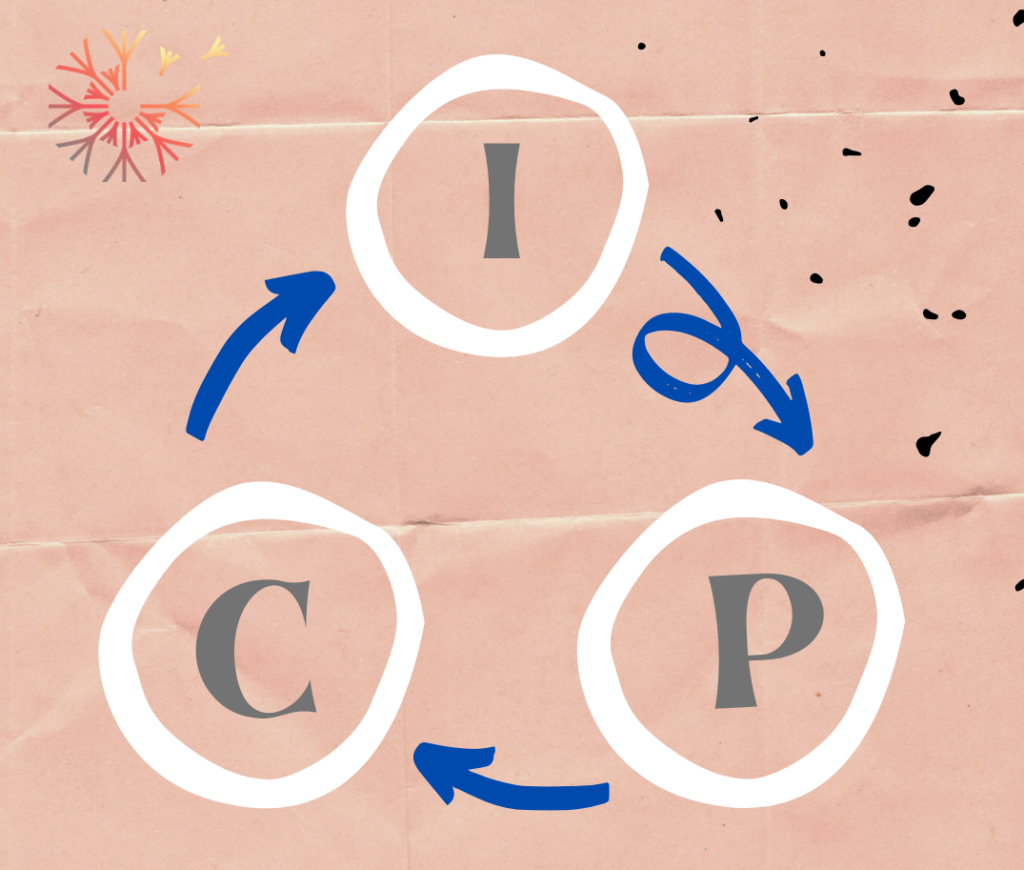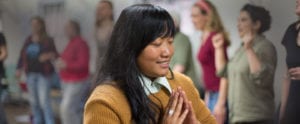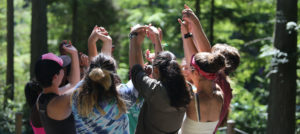“What makes you think they will do that?” asked our co-leader Ashok as we were planning a leadership day for a diverse group of 150 teenagers coming from all over Washington State. You’d think we had suggested asking the participants to jump off a building. “We just know,” we said. But we did wonder if this would be the one time it wouldn’t work.
Upon arrival, the teenagers tumbled off the bus and entered a large room with long tables filled with art supplies. They hung around the tables and made their name tags with great joy. Their glee continued, as later they introduced themselves using sounds to show how they feel. Ashok stood wide eyed: “I can’t believe what I’m seeing.”
That initial enthusiasm remained throughout the day as the youth and their mentors participated in a variety of leadership activities that were embedded with opportunities to engage their imaginations. By day’s end, Ashok was won over. “I never realized how powerful using the arts can be. Something quite different happened today—something deeply meaningful.”
Fortunately, the youth had proved us right. What worked here?
Our proven I-P-C Model of group development. It explains why beginning a program with something like making creative name tags can get people engaged right off the bat, and keeps doing so continually.

When you first come together with your group, if you invite people to do a low-risk activity that engages the imagination, they get the message that their whole self is welcome here. Not just their brains, in the case of a classroom, or their brawn, in the case of a service-learning project like restoring a stream. Their entire self is welcome: their personality, quirky humor, unique ways of expression, and their emotions.
When people get the message that their whole self is invited in, they are more inclined to participate. We saw this in the case of the youth leadership program at the Seattle Center. And we see it in every program we lead. The discovery of what’s possible when we truly express our imagination, increases our creative confidence and our willingness to try new things.
When people participate using their imaginations, this in turn leads to commitment. People simply come on board with what’s happening and want to be part of it.
I-P-C is not just a key for starting your program off well. When your group gets tired and the energy falls flat, rather than cajole or coerce people into coming back to attention, we recommend jumping back into the IPC cycle with an activity that calls on the imagination. Something as simple as an imaginative stretch will do the trick:
“Hey everyone, let’s imagine that we are puppets. The great puppeteer in the sky is taking hold of your hands and pulls them up and lets them down and now up, right out of your seat. And now the puppeteer pulls your arms back and forth so you are swaying as if in a soft breeze. Great, now everyone take a deep breath, let it out, sit back down, and let’s get started again.”
It turns out that engaging the imagination has other big benefits for learning. A study conducted by Scott Barry Kaufman, Scientific Director at UPenn’s Positive Psychology Center, shows that activating our imagination involves both deliberate focus, as well as large scale brain activity or ‘wandering’ that happens when the brain isn’t engaged in a specific task. It involves both divergent and convergent thinking. This strengthens our creative thinking, helping us solve problems in unique ways. That’s a critical 21st-century skill!
Youth workers and facilitators across the world use our I-P-C framework to make learning matter:
- “The imagination games are mindful and also give me new ideas in order to be more creative in this critical moment of teaching online during the pandemic.”
- “Learning to build trust and engagement through bite-sized pieces of imagination has been very eye-opening. It’s made all the difference.”
- “Through the IPC model I now have a repository of creative, interactive activities to help engage my students.”
There’s also a growing body of research that underscores the critical role of imagination in our lives. Studies confirm that imagination can impact our brains and bodies in ways that matter for our wellbeing. For example, one study showed that divergent thinking was strongly associated with preadolescents’ ability to cope in stressful situations. Further research confirms that “creative answers” are a common reaction to strong emotions, and creative self-expression may serve as a buffer for the adolescent’s typical “storm and stress.”
We encourage you to find low risk ways to engage the imagination in your groups and see what happens. To get you started, here are three simple activities:
- Yes, And… is a storytelling game that develops listening skills, and generates joy.
- Yes, Let’s engages the imagination, body, voice, and fosters a “yes” atmosphere.
- This is not a… leads to divergent thinking, collaboration, and stepping out of comfort zones.
We expect you’ll be mightily surprised as you find new ways of using the IPC!
Authors: Nilisha Mohapatra, Andrew Nalani and Peggy Taylor




